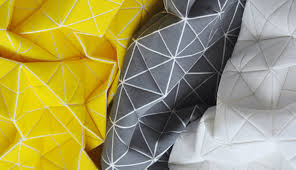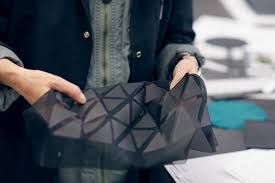“Smart Fibers, Mighty Fabrics: Unraveling the Future of Technical and E-Textiles”**
The Unsung Hero: Technical Textiles and the Future of Smart Fabrics**
Picture this: You’re walking through a bustling city, the hum of machinery and the rhythmic beat of daily life surround you. But wait, it’s not just concrete and steel propping up this metropolis—there’s a quiet revolution at play—a fabric that holds the city together almost quite literally! This is the world of technical textiles, an often overlooked but firmly integral part of our modern tapestry. Today, let’s unravel the wonders of this underrated invention and peer into the mystifying world of smart textiles. Fasten your seat belts; Textile Topher is on a magical ride through the textile wonderland!
The Unsung Story of Technical Textiles
Technical textiles are engineered fabrics that serve a multitude of functions beyond traditional aesthetics, drapery, or insulation. Whether it’s the robust conveyor belts hauling resources in an industrial plant, the fire-resistant gear safeguarding our brave firefighters, or the filtration fabrics purifying air and water, technical textiles showcase versatility that is virtually unmatched. What makes these fabrics so special is their ability to perform reliably under extremes of stress and harsh environments.

But why haven’t these awe-inspiring textiles claimed the spotlight they so richly deserve? In a world buzzing with advancements in digital technologies, biotechnology, and AI, textiles often appear mundane. Yet, peel away that façade, and you’ll uncover innovation woven into the very fibers of these fabrics.
Consider the term *geomembrane*. A geomembrane is a classic example of technical textiles. It’s used extensively in civil engineering projects to manage waste, control erosion, and support infrastructure. Made from chemically stable polymers, these membranes are waterproof and resilient, capable of withstanding significant stress and environmental shifts. Now, that’s fabric with a purpose!
Weaving Magic with Smart Textiles
Now, imagine if textiles could think, respond, and adapt. Smart textiles, or e-textiles, do precisely that. These are fabrics integrated with cutting-edge technologies that enable them to interact with their surroundings intelligently. Embedded with sensors, conductive threads, and microprocessors, smart textiles bring fabrics to life. From sportswear that monitors physiological signals to hospital gowns that track patient vitals, the applications are boundless.
One pivotal keyword here is *conductive thread*. Unlike conventional threads, conductive threads are infused with metal, such as silver, copper, or stainless steel. This unique property allows them to conduct electricity, which opens a Pandora’s Box of possibilities—from powering up LED lights in fashion to creating touch-responsive surfaces.
Another shining star in smart textiles is the concept of *fabric sensors*. These sensors are designed to detect physical changes such as pressure, temperature, or moisture. For instance, in the realm of healthcare, bed sheets incorporated with pressure sensors can alert caregivers to prevent bedsores in bedridden patients. By converting textile surfaces into data-collecting interfaces, these fabrics seamlessly blend comfort with utility.
The Alchemy of Creating Smart Textiles
Creating smart textiles involves a harmonious fusion of traditional textile manufacturing and advanced technological integration. The production process can be technically intricate, often requiring multidisciplinary expertise. Let’s chart a condensed journey into the art and alchemy of making smart textiles.
1. Material Selection:** The foundation of any textile lies in its material. For smart textiles, materials must strike a balance between conventional textile properties (like softness and breathability) and technical functionality (like conductivity and durability). Polymers, nano-materials, and modern composites often take center stage.
2. Integrating Electronics:** This phase is akin to stitching the soul into the fabric. By employing techniques such as weaving, knitting, or embroidery, electronic components like sensors and conductive threads are meticulously integrated. Imagine sewing a network of nerves into the fabric, each capable of sensing, reacting, and even communicating—pure wizardry!
3. Power Solutions:** To make these smart fabrics functional, they need a source of power. Enter flexible batteries and energy-harvesting technologies. Innovations such as photovoltaic cells embedded in fibers can harness solar energy, continually charging the smart textiles and ensuring uninterrupted functionality.
4. Data Processing and Connectivity:** Smart textiles capture data, but it’s the processing and connectivity that unleash their full potential. Embedded chips and microprocessors analyze the data in real time, while connectivity modules (such as Bluetooth) enable communication with external devices. Behold the smart garment—no wires attached, yet packed with digital prowess.
Applications That Transcend the Ordinary
The potential applications of smart textiles are as diverse as they are revolutionary. Think of sectors like healthcare, sports, military, and fashion—a Tsunami of innovation is sweeping across each one.
Healthcare: The Future Fabric of Life
Medical textiles are undergoing a renaissance, driven by the integration of smart technologies. Imagine a world where your T-shirt can monitor your heart rate, or where bandages automatically release medication and track healing. Such advancements can significantly improve patient outcomes and revolutionize remote health monitoring.
Smart bandages that leverage *biosensors* are a prime example. These bandages aren’t just passive protectors; they actively observe wound conditions and inform healthcare providers about the healing progress. This targeted approach minimizes complications and customizes treatment protocols to individual needs.
Sports: Elevating Performance
In the domain of sports, smart textiles are a game-changer. By embedding biometric sensors into athletic wear, these garments provide real-time data on performance metrics such as sweat levels, muscle activity, and heart rate. Data-driven insights allow athletes to optimize their training regimens, enhance their performance, and reduce the risk of injuries.
Consider the use of *accelerometers* in smart sportswear. These devices measure acceleration forces, helping athletes fine-tune their movements and postures. Imagine a sprinter refining their stride or a swimmer perfecting their stroke, all thanks to the precise biomechanics feedback provided by their attire.
Military: The Tactical Edge
When it comes to the military, smart textiles are becoming indispensable. Smart uniforms embedded with sensors can monitor soldiers’ health, stress levels, and fatigue in real-time. Moreover, these intelligent fabrics can be designed to adapt to environmental changes, providing optimal insulation or camouflage based on situational demands.
*Phase-change materials* are remarkable in this context. These materials can absorb, store, and release heat, enabling the fabric to regulate temperature dynamically. In extreme conditions, such adaptability can be life-saving, ensuring that soldiers remain comfortable and vigilant.
Fashion: The Runway Revolution
Technology and fashion are no longer strange bedfellows. The catwalks are being transformed by smart textiles, with designers experimenting with fabrics that change color, illuminate, or even adjust their fit on-the-go. This convergence of tech and style is paving the way for personalized and immersive fashion experiences.
Luminous fabrics, incorporating *organic light-emitting diodes* (OLEDs), represent a dazzling leap. These fabrics can emit light when an electric current passes through, turning garments into canvases for digital art and personalized displays. The possibilities for creativity are virtually endless!
The Challenges and Future Prospects
While the horizon gleams with promise, the journey of smart textiles isn’t without its challenges. Durability remains a primary concern as these fabrics must endure wear and tear without compromising their functionality. The meticulous integration of electronics presents another hurdle, requiring precision to maintain textile properties while embedding technical components.
Yet, with every challenge comes the opportunity for innovation. Researchers are continuously exploring advanced materials and fabrication techniques to enhance the robustness of smart textiles. Innovations like *nanocoatings* offer potential solutions by providing protective layers that enhance the durability and performance of these textiles.
Moreover, sustainable practices are gaining traction in the realm of smart textiles. The emphasis is shifting towards environmentally friendly materials and processes. For instance, biodegradable sensors and eco-friendly conductive threads are being developed to minimize the environmental impact of smart textiles.
A Glimpse into the Future
The future of smart textiles gleams with potential. Rapid advancements in materials science, electronics, and data analytics are poised to transform these intelligent fabrics into seamless extensions of our lives. Imagine fabrics that adapt their properties to external conditions, garments that provide real-time health diagnostics, and textiles that harness renewable energy—this isn’t science fiction; it’s the next frontier of innovation.
Notably, the concept of *self-healing textiles* is gaining ground. These fabrics have the ability to repair minor damages autonomously, akin to biological tissues. By incorporating microcapsules filled with repair agents or utilizing responsive polymers, researchers are crafting textiles that can extend their lifespan and maintain functionality even after sustaining mechanical damage.
As the world hurtles towards a future where connectivity and intelligence are paramount, smart textiles stand at the cusp of redefining our interactions with the fabric of our lives. They embody the spirit of convergence, where traditional craftsmanship intertwines with cutting-edge technology, creating a harmonious symphony of innovation and practicality.
Concluding Threads
As we unravel the threads of this narrative, we find that technical and smart textiles are not merely fabrics; they are the silent champions of innovation woven into the very fibres of our existence. From the robust geomembranes fortifying our infrastructure to the intelligent fabrics monitoring our health, these textiles serve as a testament to the boundless ingenuity of human creativity.
In the end, the true beauty of technical and smart textiles lies in their ability to transcend the ordinary, transforming everyday interactions into extraordinary experiences. So, let’s celebrate these unsung heroes, for they are the fabric of our future, promising a world where textiles do more than clothe—they connect, protect, and enchant.
And there you have it, dear readers—a peek into the magical realm of technical and smart textiles. As we continue to explore this textile wonderland, one thing is certain: the future is woven with innovation, one resilient, intelligent thread at a time. Until next time, this is Textile Topher signing off, ready to dive into the next wave of textile marvels. Stay curious, stay woven in wonder!
Keywords: Technical Textiles, Smart Textiles, Conductive Threads, (Post number: 7), Biosensors, Fabric Sensors





